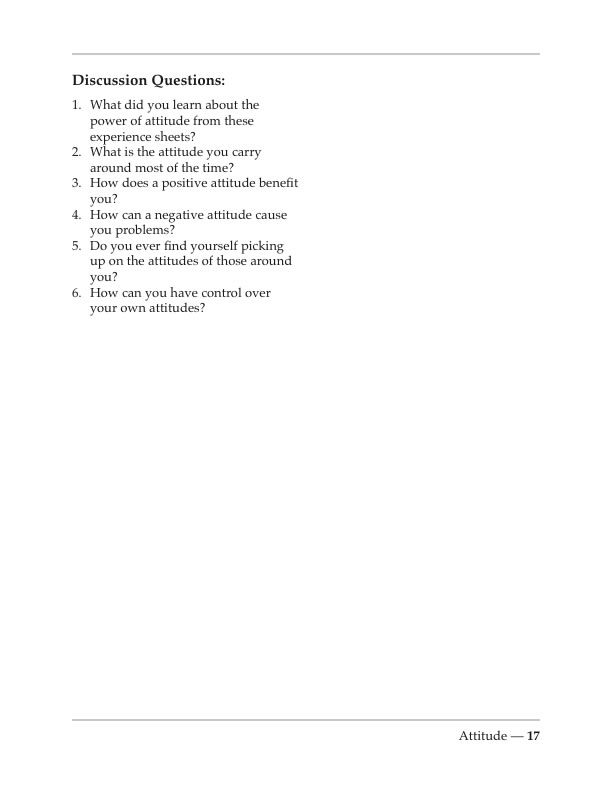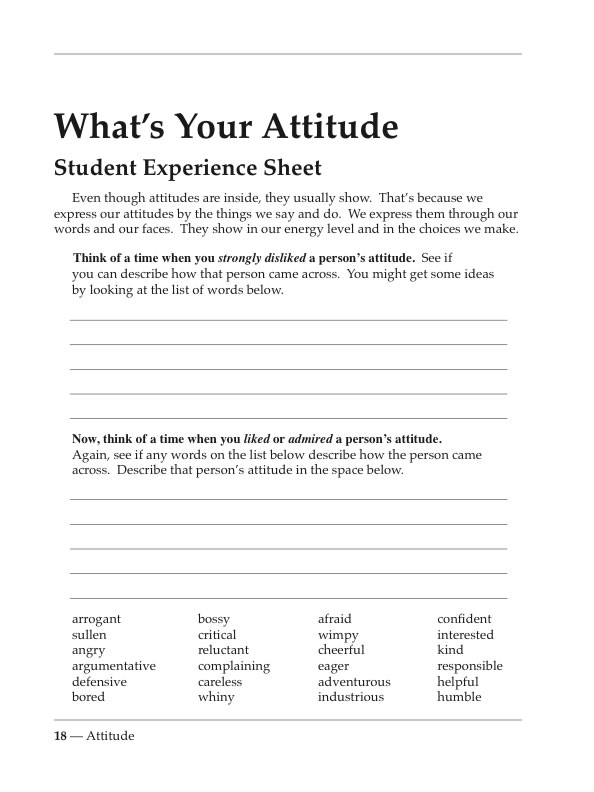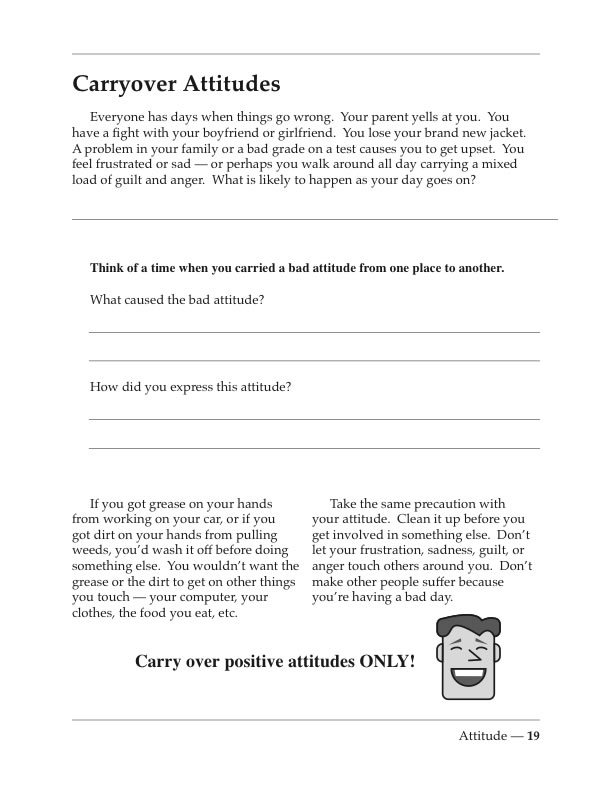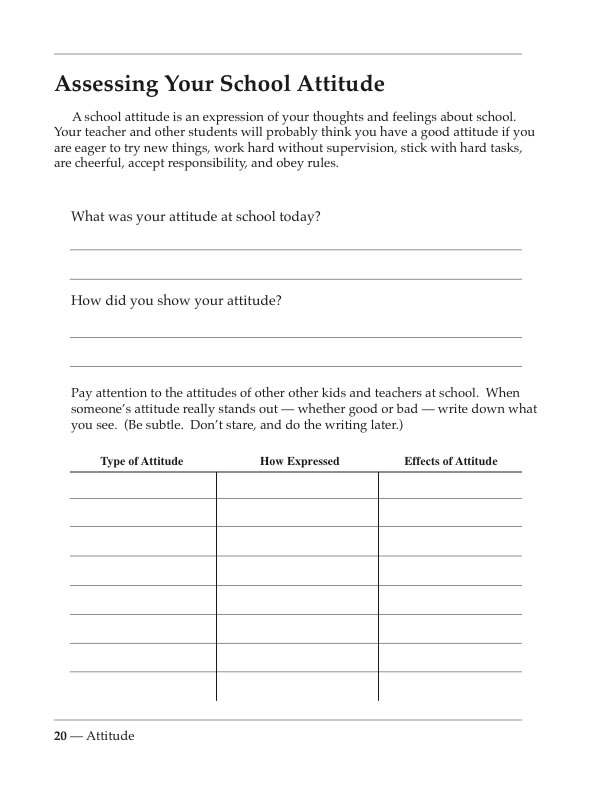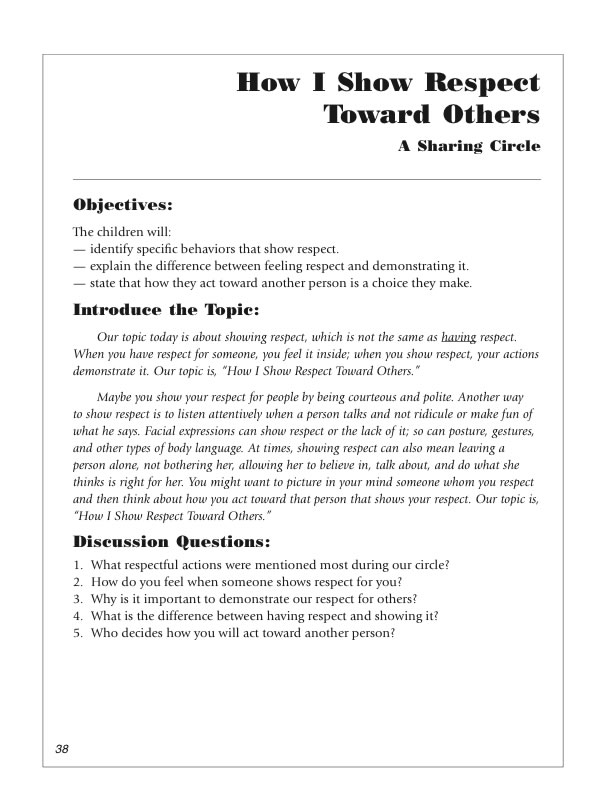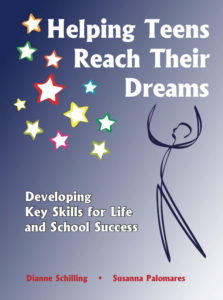
It’s All About Attitude
It has been said that life is forty percent what we make it, and sixty percent how we take it. Whatever the ratio, the point is clear that attitude is a defining lens. We always have a choice about how we respond to events in our lives.
To recognize the benefits of developing positive, responsible attitudes, young people must first grow in self-awareness. They must learn to understand feelings and their relationship to thoughts, and they must understand that their own feelings are normal, predicable, and susceptible to control. Feelings convey messages about conditions and events going on in the environment, and provide important clues to the way the brain is processing information.
As William James said over one hundred years ago, “Human beings, by changing the inner attitudes of their minds can change the outer aspects of their lives.”
A Tool You Can Use
This week’s activity helps students learn about the power of their attitudes – how negative attitudes cause problems and how positive attitudes can be a benefit to all aspects of their lives. The activity, Developing a Positive Attitude, has two parts – a group discussion followed by an experience sheet.
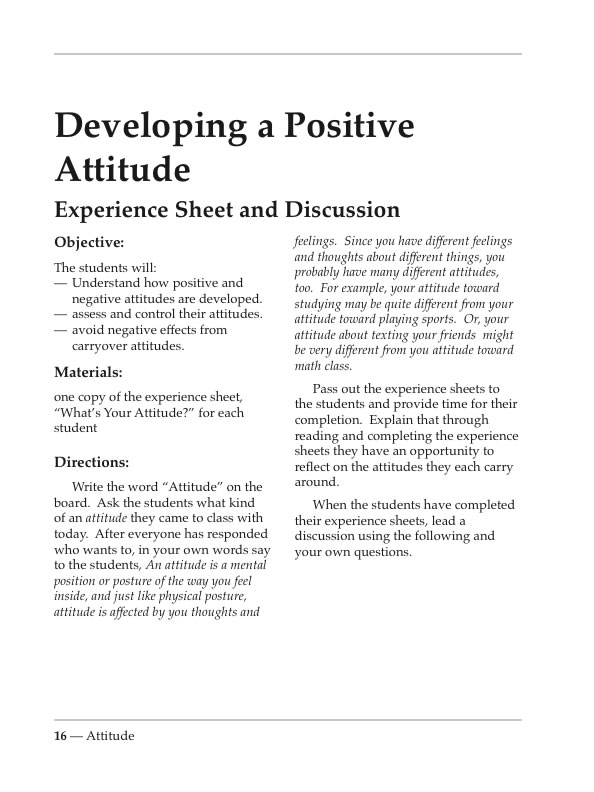
You can check the book out HERE.
Just click HERE to open a fully reproducible PDF of this activity and experience sheet…
If you like our blog resources and would like to receive them regularly, please subscribe here or on our website at www.InnerchoicePublishing.com
If you are already a subscriber, I hope you find this activity valuable. Help us grow our blog by sharing these activities and encouraging others to join. Thank you.
Thanks so much for reading!
Susanna
How I Show Respect Toward Others
Reflections on Respect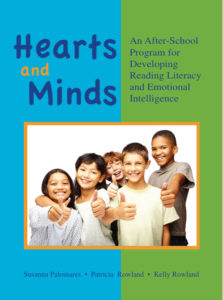 Here’s a follow up on last week’s Blog which discussed the importance of teaching students the value of respect. Helping students understand the significance of a respectful attitude and helping them identify specific actions and behaviors that demonstrate respect is the purpose of today’s Sharing Circle. This Sharing Circle topic comes from the activity book (Grades 3-6), Hearts and Minds – An After-School Program for Developing Reading Literacy and Emotional Intelligence. The topic is, How I Show Respect Toward Others…
Here’s a follow up on last week’s Blog which discussed the importance of teaching students the value of respect. Helping students understand the significance of a respectful attitude and helping them identify specific actions and behaviors that demonstrate respect is the purpose of today’s Sharing Circle. This Sharing Circle topic comes from the activity book (Grades 3-6), Hearts and Minds – An After-School Program for Developing Reading Literacy and Emotional Intelligence. The topic is, How I Show Respect Toward Others…
 Here’s Your Monday Morning Sharing Circle. Enjoy!
Here’s Your Monday Morning Sharing Circle. Enjoy!
Do you want more information? • Leading a Sharing Circle • Sharing Circle Rules • Books and Resources • Free Activities • Subscribe
Here’s How It’s Done
Gather everyone into a circle. Explain the rules for sharing, and get agreement from everyone that they will follow the rules.
Sharing Circle Rules:
- Everyone gets a turn to share, including the leader.
- You can skip your turn if you wish.
- Listen to the person who is sharing.
- There are no interruptions, probing, put-downs, or gossip.
- Share the time equally.
After everyone has shared, who wants to share, ask the discussion questions. Get more in-depth information here.
Just click HERE to open a fully reproducible PDF of this Sharing Circle activity…
If you like our blog resources and would like to receive them regularly, please subscribe above or on our website at www.InnerchoicePublishing.com
If you are already a subscriber, I hope you find this activity valuable. Help us grow our blog by sharing these activities and encouraging others to join.
Thank you. Thanks so much for reading!
Susanna
Activities for Teaching Respect
Teaching children about respect and developing positive relationships is one of the most important things we can do, especially in today’s increasingly disrespectful world.
What It Takes
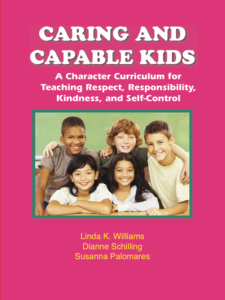
Being intentional and specifically having your students engage in activities focussed on respect will help them to understand the importance of their respectful actions and to understanding the difference between respectful and disrespectful actions and words.
Respect means showing regard for the worth of someone or something. It includes respect for self (self-esteem), respect for others, and respect for the environment, including other life forms. All other varieties of respect are outgrowths of these three. Respecting someone’s property, for example, extends from respecting the owner of the property.
When we teach students to show respect, we prevent them from hurting what they ought to value. If we are completely successful, they will end up valuing that for which they have demonstrated respect.
Other ways to foster respect include:
- Create a democratic classroom environment, in which the rights of all students are respected. Show your own regard for every student, every day.
- Expect students to be polite and courteous. Consistently model the use of “please,” “thank you,” “excuse me,” etc.
- Really listen to the opinions and contributions of students. Make it a rule that students listen respectfully to each other.
- Show your appreciation for diversity. Create an environment in which individual differences are celebrated, and where all students feel included and interdependent.
- Teach students a simple decision-making process and encourage them to use it. Respect their ability to make decisions for themselves. Serve as their advisor and consultant.
- When students have difficulty understanding how their behavior affects others, suggest that they apply the classic test of reversibility. Ask them: Would you want to receive this kind of treatment?
Here’s a great activity for working on one important aspect of RESPECT:
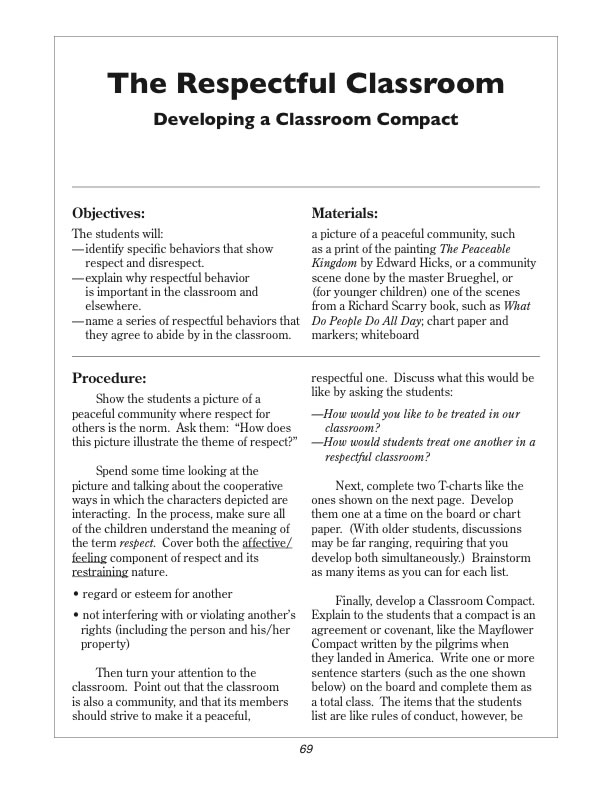
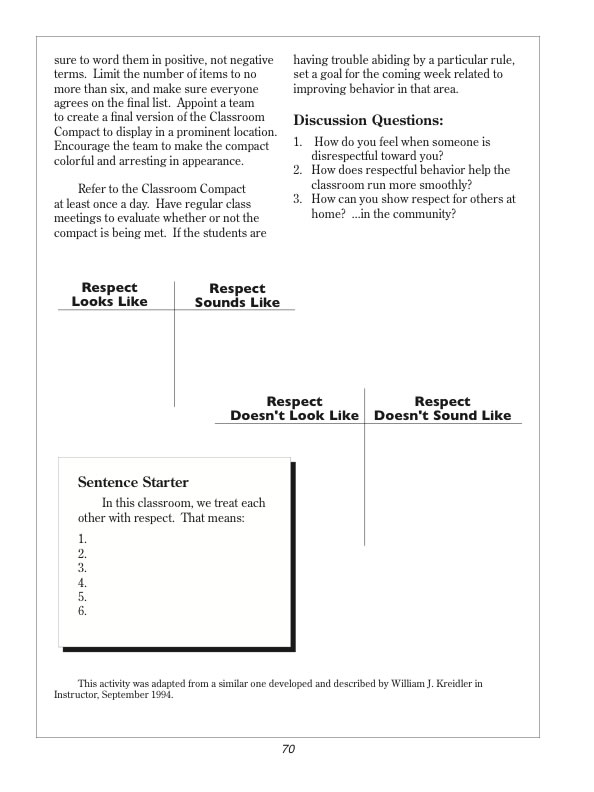
You can check the book out HERE.
If you like our blog resources and would like to receive them regularly, please subscribe here or on our website at www.InnerchoicePublishing.com
If you are already a subscriber, I hope you find this activity valuable. Help us grow our blog by sharing these activities and encouraging others to join. Thank you.
Thanks so much for reading!
Susanna
Back to School Ideas for Getting to Know Your Students
Getting a Good Start
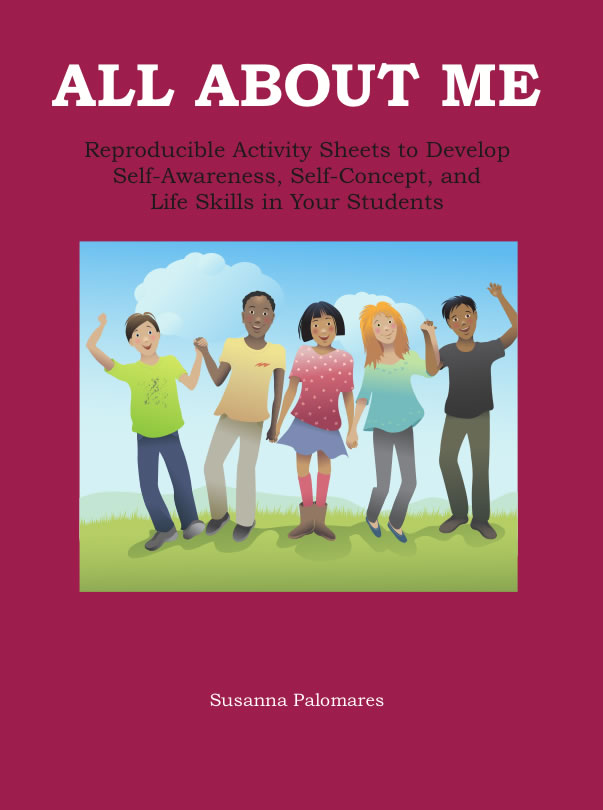
It’s your first day of school and you have a whole new group of students to get to know. By being interested in who they are as people, their interests, feelings, experiences, backgrounds etc., you’re making them feel welcome and setting a tone of caring, and by making them feel welcome and showing that you care you’re building positive relationships and winning them over right from the start. When you get to know your students on a personal level you’ll have a better understanding of group interactions, personal likes and dislikes, and motivating interests. This can help you plan lessons, organize groups, and diffuse potential problems.
Some Great Resources
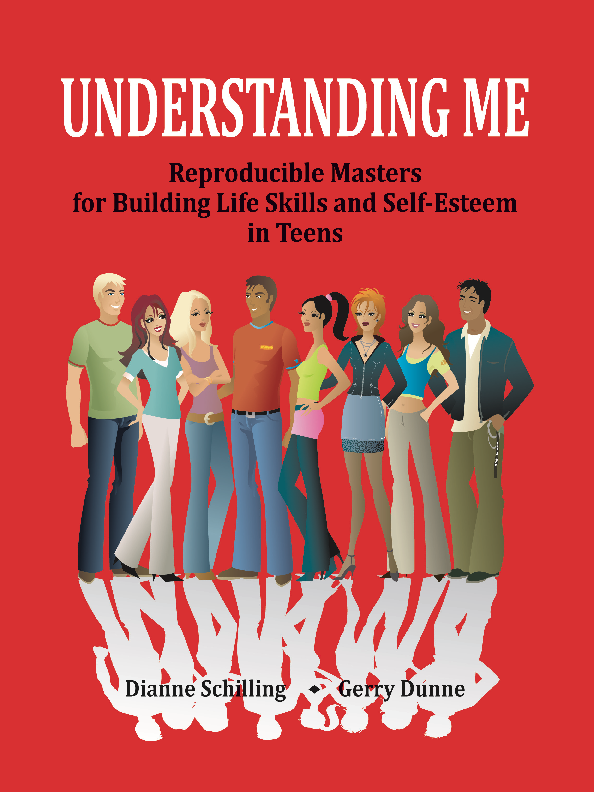
Here are a few quick activity sheets and some suggestions for follow up group interactions that help you to get to know your students and for them to get to know each other.
One Last Thought…
It’s important to remember that building positive relationships and maintaining a classroom of caring is about taking time on a regular basis to be in touch with the human side of your students. Check out more activities from the many books available from the Innerchoice Publishing website
Activities for the elementary grades – All About Me
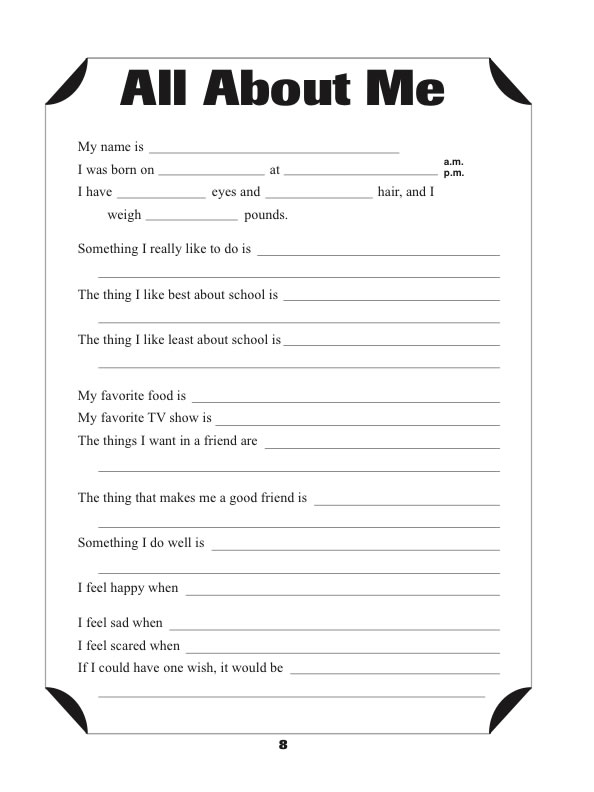
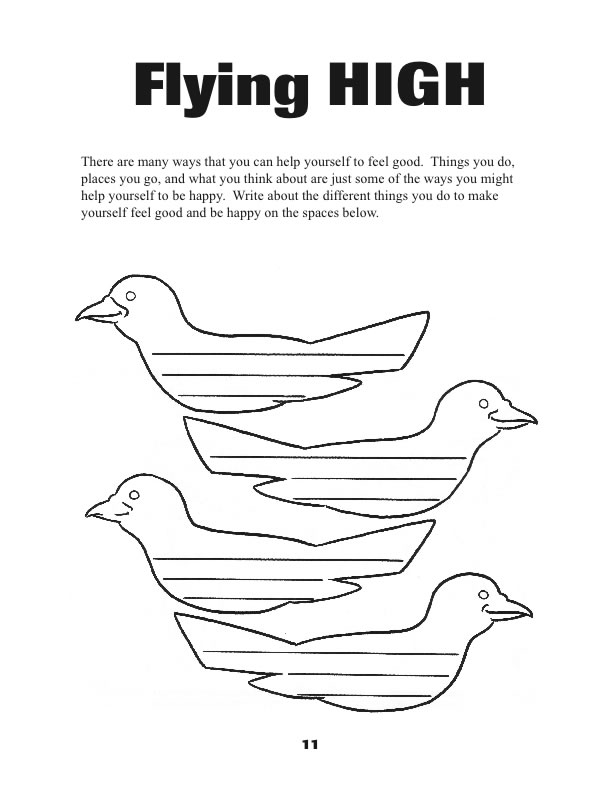
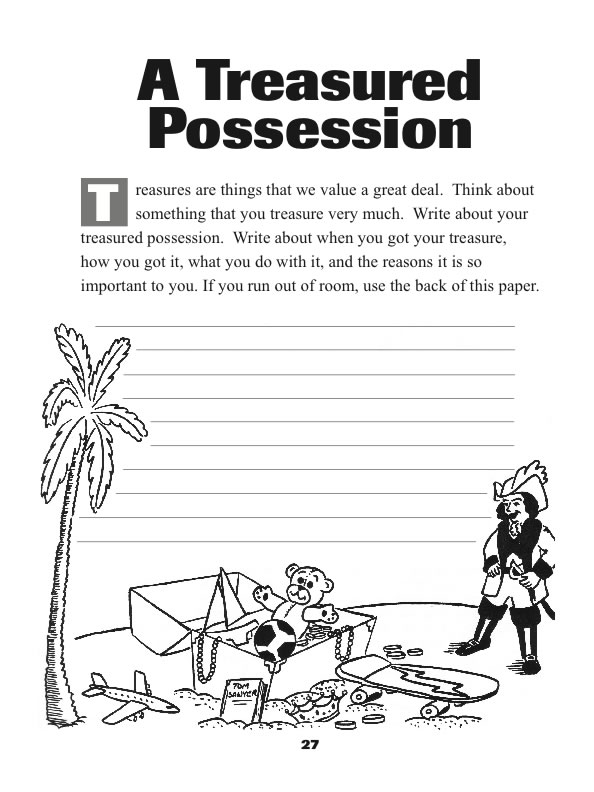
Activities for the secondary grades – Understanding Me
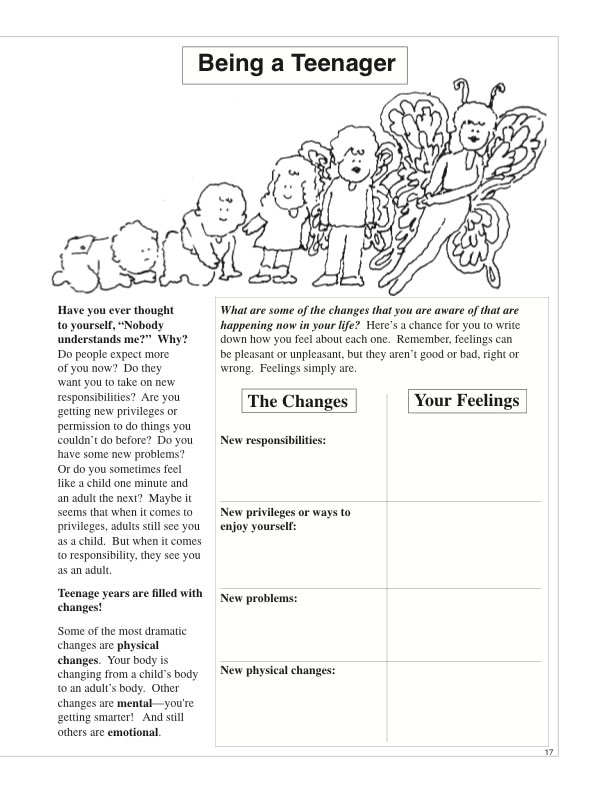
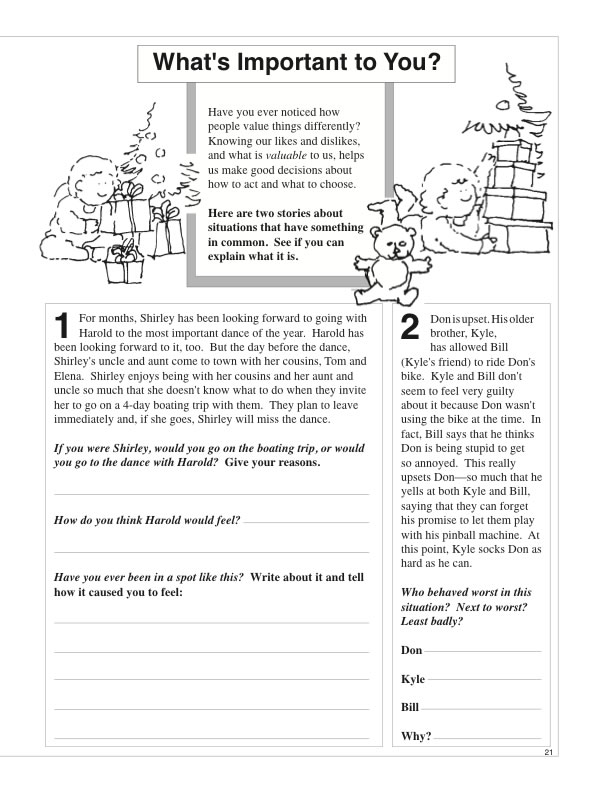
An Expression of Social-Emotional Learning
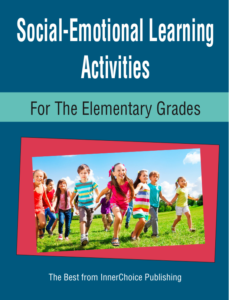
Never neglect or take for granted the emotional life of your students. Feelings, self-awareness, life skills, conflict management, self-esteem, and all of the other developmental areas now identified as social emotional learning are critically important. An impressive array of research from multiple fields supports the validity of time and energy spent by educators in these domains. Emotions are not unruly remnants of stone-age survival to be hushed and otherwise ignored while we develop cognitive skills. Emotions drive our behavior, shape our values, and predispose us to choose one course of action over others. Emotional and rational skills are equally important interdependent components of human intelligence.
This Sharing Circle topic comes from the elementary grades activity book, Social-Emotional Learning Activities For The Elementary Grades. The topic is, A Time I Showed Someone That I Care…
 Here’s Your Monday Morning Sharing Circle.
Here’s Your Monday Morning Sharing Circle.
Enjoy!

Do you want more information?
• Leading a Sharing Circle • Sharing Circle Rules
• Books and Resources • Free Activities • Subscribe
Here’s How It’s Done
Gather everyone into a circle.
Explain the rules for sharing, and get agreement from everyone that they will follow the rules.
Sharing Circle Rules:
• Everyone gets a turn to share, including the leader.
• You can skip your turn if you wish.
• Listen to the person who is sharing.
• There are no interruptions, probing, put-downs, or gossip.
• Share the time equally.
After everyone has shared, who wants to share, ask the discussion questions.
Get more in-depth information here.
Just click HERE to open a fully reproducible PDF of this Sharing Circle activity…
If you like our blog resources and would like to receive them regularly, please subscribe here or on our website at www.InnerchoicePublishing.com
Thanks so much for reading!
Susanna
PS: If a friend forwarded this to you, you can just sign up to get your own weekly Innerchoice Counselor Activit
A Lifetime Skill – Handling Peer Pressure
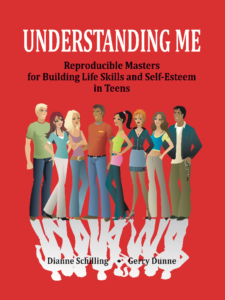
In virtually every area of living life skills are needed. Along with math, science, technology, history and English, students also need to be taught how to manage themselves, their time and activities. They need to know how to get along with others and to formulate goals and communicate their needs in a pro-social manner. Too often these critical life skills are not addressed in a direct fashion but their acquisition is simply left to chance. Students often don’t learn effective ways to deal with life issues. They have ideas but can’t express them clearly. They get into conflicts they don’t know how to resolve. They have hopes and dreams but can only drift through life.
The Current Reality
Often it’s the lack of skills and awarenesses that prevent many from becoming fully capable, contributing, happy members of society. School is the ideal places to directly teach life skills, both for their impact on the future and because life skills ensure the effective application of academic skills today.
Here’s a Resource and How to Use It
Understanding Me develops, maintains, and enhances critical life skills. Among the life skills addressed in these activity sheets are:
• decision making
• goal setting
• communication
• conflict management
• learning
• leadership
• time management
• responsibility
• assertiveness
• career choic
• trust
• friendship
• culture
• justice
In addition to your own enabling behaviors and the cultivation of an affirming classroom or counseling environment, you can assure a positive impact on the social-emotional development of your students by infusing these activities into your regular curriculum or counseling efforts. They represent one of many possible approaches and can be enlisted as supplements to other strategies you are currently using.
A Complimentary Activity
UNDERSTANDING ME is packed with meaningful information for teens to learn new ideas, attitudes, behaviors, perspectives, and skills while promoting self-awareness and self-esteem. These flexible worksheets can be used by anyone working with teens – teachers, counselors, youth group and after-school leaders, home-schoolers, and parents.
Today’s selected student activity is entitled Pressure!. What is Peer Pressure and what do you do with it?
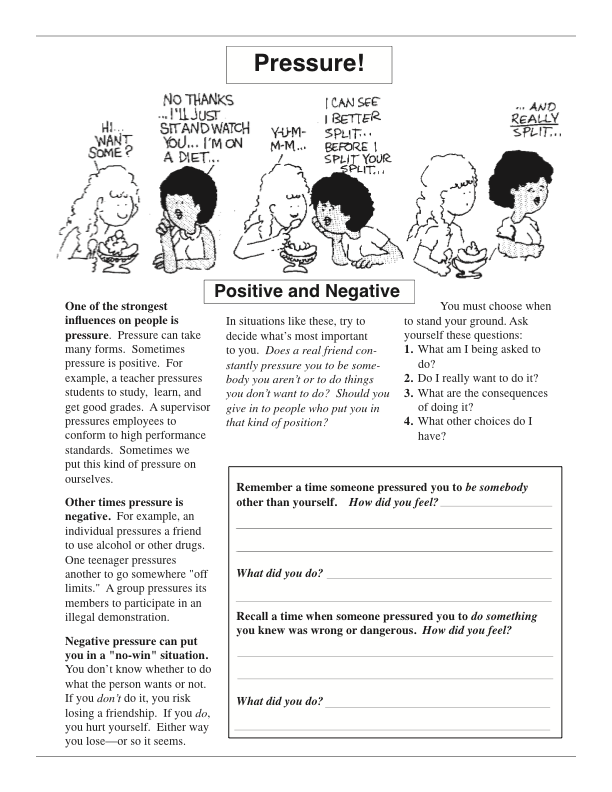
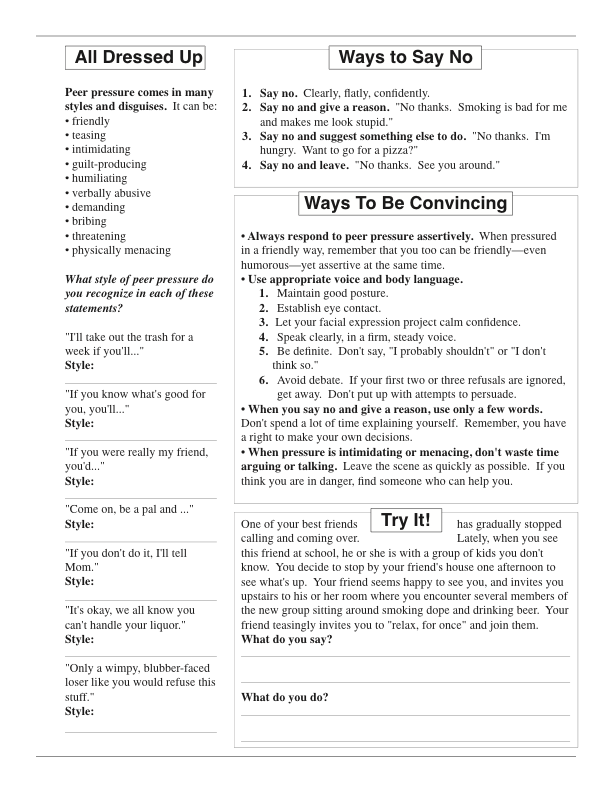
Use this activity now, and purchase the book to have a whole library of instantly usable social skills skills activities with which to engage your students.
You can check the book out HERE, and you can open a reproducible PDF of your student activity HERE.
If you like our blog resources and would like to receive them regularly, please subscribe here or on our website at www.InnerchoicePublishing.com
Thanks so much for reading!
Dianne Schilling & Gerry Dunne (Authors)
How Feelings Factor Into Conflict
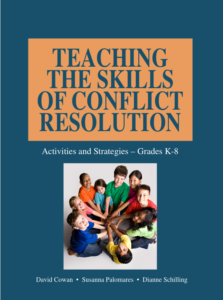
This Sharing Circle topic comes from the grades K-8 resource book, TEACHING THE SKILLS OF CONFLICT RESOLUTION.
Children who have learned to understand, accept, and control their feelings are not only less vulnerable to conflict, they are better equipped to deal constructively with conflict when it occurs. This Sharing Circle will allow students to better understand the connection between feelings and behavior. The topic for this Sharing Circle is, Something I Do That Makes Me Happy…
 Here’s Your Monday Morning Sharing Circle.
Here’s Your Monday Morning Sharing Circle.
Enjoy!
Something I Do That Makes Me Happy
Objectives:
The students will:
— identify something that they enjoy doing.
— state that all people can make themselves feel better.
Introduce the Topic:
Today we are going to think about things that we do to make ourselves feel good. The topic is, “Something I Do That Makes Me Happy.”
Do you know that you can make yourself feel happy? We all do things every day to help ourselves feel good. We give hugs to people we love, and that feels good. We sometimes sing or dance or tell jokes to make ourselves happy. We might make ourselves happy by playing a favorite game or reading a good book; by getting together with a close friend, playing with a pet, relaxing in front of T.V., or taking a walk. Close your eyes right now and think of one thing that you do to make yourself happy. Maybe you eat a favorite snack in the afternoon, or cuddle up with your cat. Perhaps you paint, or work on your computer. Take a few moments to think about it. The topic is, “Something I Do That Makes Me Happy.”
Discussion Questions:
1. Why is it important to know how to make yourself feel better?
2. What ideas did you hear that you’d like to try?
3. Who is in control of how you feel? Explain.
Do you want more information?
• Leading a Sharing Circle • Sharing Circle Rules
• Books and Resources • Free Activities • Subscribe
Here’s How It’s Done
Gather everyone into a circle.
Explain the rules for sharing, and get agreement from everyone that they will follow the rules.
Sharing Circle Rules:
• Everyone gets a turn to share, including the leader.
• You can skip your turn if you wish.
• Listen to the person who is sharing.
• There are no interruptions, probing, put-downs, or gossip.
• Share the time equally.
After everyone has shared, who wants to share, ask the discussion questions.
Get more in-depth information here.
Just click HERE to open a fully reproducible PDF of this Sharing Circle activity…
If you like our blog resources and would like to receive them regularly, please subscribe here or on our website at www.InnerchoicePublishing.com
Thanks so much for reading!
Susanna
PS: If a friend forwarded this to you, you can just sign up to get your own weekly Innerchoice Counselor Activity Blog.
Helping Children Deal Constructively with Anger and Conflict
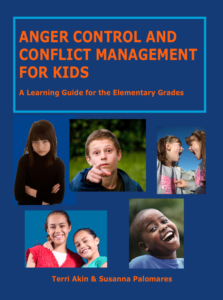
Everyone gets angry, and everyone gets involved in conflict. Both are normal human experiences and often one leads to the other. Anger can lead to conflict, and conflict can lead to anger. They generally go together and it’s hard to tell which came first anger or conflict. Indeed, it’s often difficult to tell them apart. It’s only natural then that the teaching of the skills and awarenesses that lead to the ability to effectively managing these powerful emotional events be taught together. Children need to learn effective ways to control, express, and release their anger and strategies for dealing with the conflicts that inevitably arise in life.
The Reality
Because so many influences in their lives teach otherwise, powerful approaches and consistent intervention are needed to teach children positive, social and emotional skills. Practice makes perfect. Repeated exposure to positive alternatives, consistent reinforcement, and practice. Lots of practice!
A Complimentary Activity
Learning together in a classroom or counseling session makes it easier to internalize the skills, strategies, and methods of anger control and conflict management. We all are social beings designed by our long evolutionary history to learn our interactive behaviors with others. The activities in ANGER CONTROL AND CONFLICT MANAGEMENT FOR KIDS are designed to actively engage the students with each other in applying knowledge, solving problems, communicating, cooperating, and relating experiences to their own lives. They demonstrate to students the power of approaching anger and conflict with a win-win attitude, and to teach them a number of basic pro-social strategies for managing anger and resolving conflict. The experiential group activities included in this book examine the nature of anger and conflict as well as their causes, effects, and resolutions. A unique Sharing Circle and role-play process builds into the learning experience repeated opportunities for behavioral rehearsal.
Today’s selected group activity is Learning to Control My Anger.
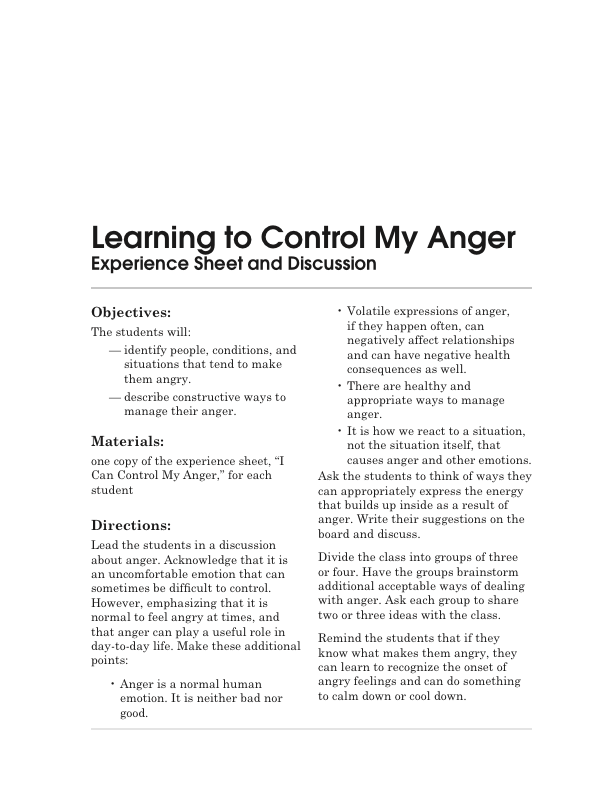
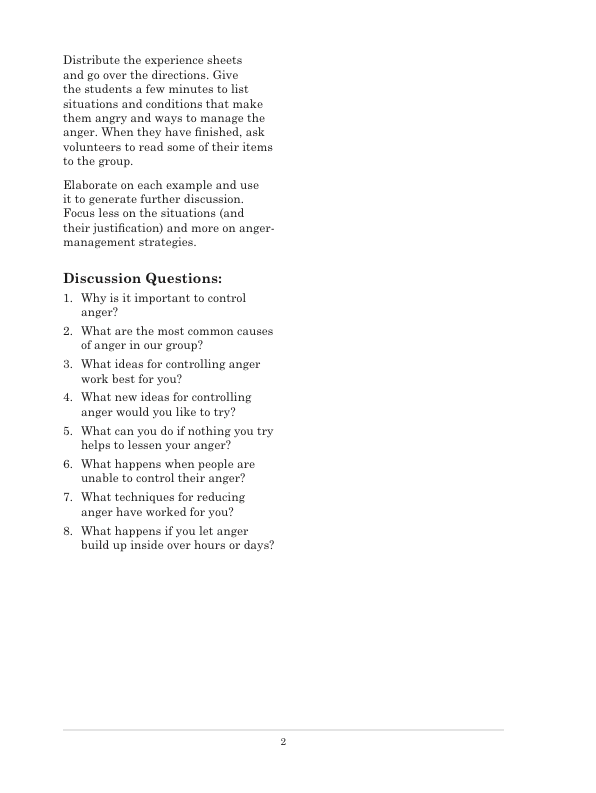
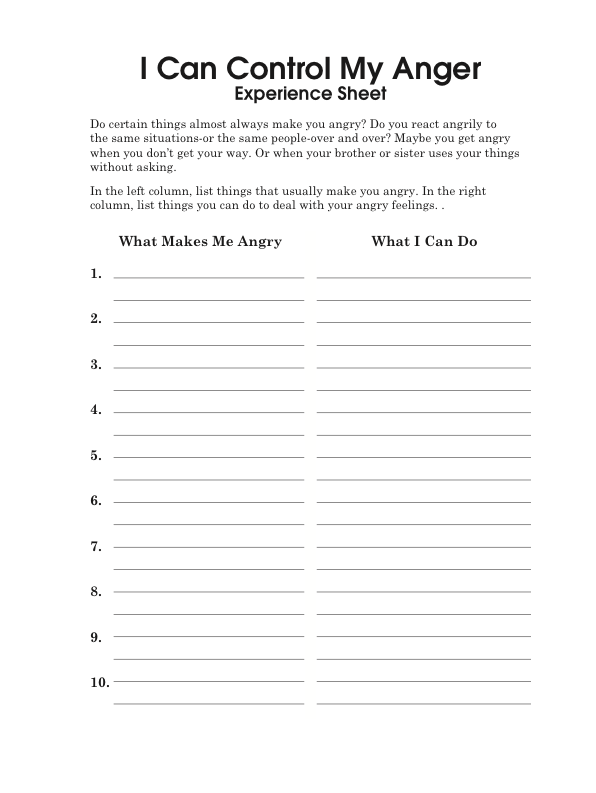
Use this activity now, and purchase the book to have a whole library of instantly usable social skills skills activities with which to engage your students.
You can check the book out HERE, and you can open a reproducible PDF of your student activity HERE.
If you like our blog resources and would like to receive them regularly, please subscribe here or on our website at www.InnerchoicePublishing.com
Thanks so much for reading!
Terri Akin & Susanna Palomares (Author)
Creating Character Education One Activity At A Time With Sharing Circles

This Sharing Circle topic comes from the grades 3-8 resource book, Guided Discussions for DEVELOPING CHARACTER. Your students will build an understanding of character and its impact on them and the world around them. The topic helps your students identify the specific behaviors that comprise proactive, responsible citizenship. The topic for this Sharing Circle is, How I Show That I’m a Good School Citizen…
 Here’s Your Monday Morning Sharing Circle.
Here’s Your Monday Morning Sharing Circle.
Enjoy!
How I Show That I’m a Good School Citizen
Purpose:
To identify and discuss specific behaviors that comprise proactive, responsible citizenship.
Introducing the Topic:
In your own words, say to the students: We have two major jobs to do at school. One is to be a good student — to study and learn. The other is to be a contributing member of the school community — a good citizen. In this session, we’re going to focus on the job of citizenship. Our topic is, “How I Show That I’m a Good School Citizen.”
Tell us one way in which you demonstrate that you are a good citizen here at school. Think about the things you do in class and on the playground that help the school community function well. Maybe you make a habit of always following the rules. Perhaps you volunteer for jobs in the classroom, like erasing the board, putting away materials and equipment, or tutoring other kids. Or maybe you participate in a school-wide volunteer group, such as the safety patrol, or the conflict mediation team. Do you always put your trash in a trash receptacle? Do you take home notices and bring back permission slips on time? Do you take part in special events, like assemblies, holiday celebrations, and open house? Think about it for a few moments. Being a good citizen involves many different kinds of attitudes and actions. Our topic is, “How I Show That I’m a Good School Citizen.”
Discussion Questions:
— Why is it important to be a good school citizen?
— How is being a good citizen of the school similar to being a good citizen of the community? How is it different?
— Is part of being a good citizen encouraging others to be good citizens? What are some examples?
Do you want more information?
• Leading a Sharing Circle • Sharing Circle Rules
• Books and Resources • Free Activities • Subscribe
Here’s How It’s Done
Gather everyone into a circle.
Explain the rules for sharing, and get agreement from everyone that they will follow the rules.
Sharing Circle Rules:
• Everyone gets a turn to share, including the leader.
• You can skip your turn if you wish.
• Listen to the person who is sharing.
• There are no interruptions, probing, put-downs, or gossip.
• Share the time equally.
After everyone has shared, who wants to share, ask the discussion questions.
Get more in-depth information here.
Just click HERE to open a fully reproducible PDF of this Sharing Circle activity…
If you like our blog resources and would like to receive them regularly, please subscribe here or on our website at www.InnerchoicePublishing.com
Thanks so much for reading!
Susanna
PS: If a friend forwarded this to you, you can just sign up to get your own weekly Innerchoice Counselor Activity Blog.
We All Need To Be Getting Along!

What does it take for people to get along? What is required for individuals and groups from diverse backgrounds to willingly seek common ground while respecting and proudly maintaining the sundry paths that brought them to the places they share?
The Reality
Our multicultural society is made up almost exclusively of immigrants and the descendents of immigrants, many of whom arrived on these shores seeking religious tolerance and freedom from oppression. What ethics must we nourish in our children, what skills do our youth need to learn in order to appreciate the brilliant kaleidoscope of colors and cultures they have inherited? How can we get them to honor, enjoy, and protect what increasing numbers would shatter and separate into little piles of hues and textures with jagged, hostile edges?
A Place to Begin
We can start by recognizing that a school is a community and the classroom a smaller community, and that whatever happens here not only goes home, but to the theater, the mall, the library, the park, the athletic event, and the religious service. Children must grasp that in order for any of us to truly enjoy and benefit from the amenities and opportunities that are available in the community, in order for any of us to feel entirely safe and secure, in order for any of us to expect optimal conditions for learning and growth, we must ensure that those same benefits, securities, and conditions are available to all of us. In short, we must learn to get along. We don’t always have to agree. We can expect to have different ideas, different values, and different goals, but we must learn to respect one another’s rights, to work and play cooperatively, to resolve conflicts, and to take responsibility for our own behaviors and the effects those have on others and on the community as a whole.
What It Really Takes
Merely admonishing students to be “good citizens” is not enough. Most are very familiar with the label and can readily parrot all the implied expectations. For students to get along in the deeper sense characterized by true interdependence, they have to develop self-awareness; undertake responsibility for their actions; accept and appreciate differences in others; listen with empathy and understanding; communicate their thoughts and feelings accurately and assertively; include others in their activities; be open to divergent styles and points of view; work together to solve problems and complete projects; and peacefully resolve any conflicts they experience along the way. What’s more, they have to be conscious that they are doing these things, and be able to verbalize the reasons and benefits. To develop competency in these areas involves the acquisition of specific skills, along with growing awareness and open discussion concerning the process. This in turn requires not just explanation, but modeling, plenty of practice or behavioral rehearsal, and ongoing dialogue.
A Complimentary Activity
The activities in GETTING ALONG – Social Skills Activities for Middle and High School Students are designed to introduce students to these skills in a deliberate, enjoyable fashion and, in the process, elevate their awareness of the responsibility that each has to make the classroom and/or school a cooperative environment where everyone is included, where people experience true interdependence, and where dissent and conflict are never fearsome or ugly but, rather, natural and productive.
Today’s selected activity, Promoting Inclusion, comes from the unit “INCLUDING OTHERS”.
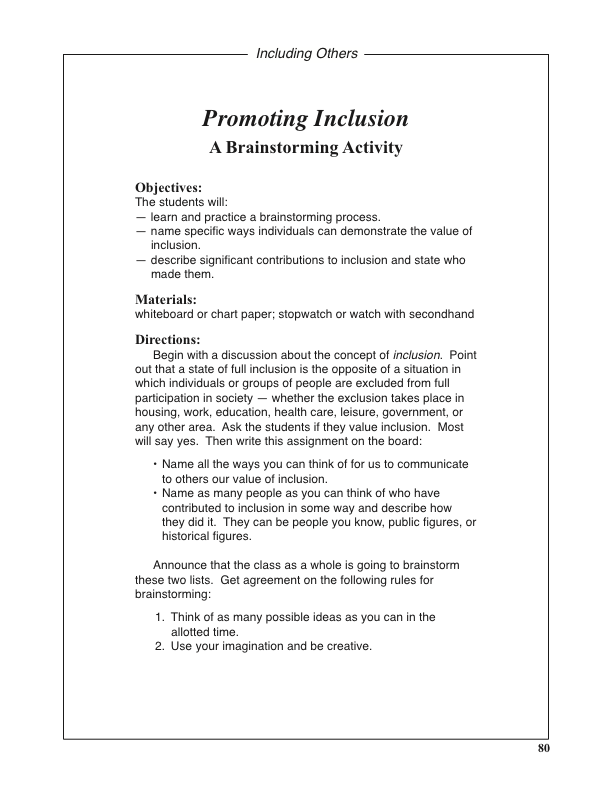
 Use this activity now, and purchase the book to have a whole library of instantly usable social skills skills activities with which to engage your students.
Use this activity now, and purchase the book to have a whole library of instantly usable social skills skills activities with which to engage your students.
You can check the book out HERE, and you can open a reproducible PDF of your student activity HERE.
If you like our blog resources and would like to receive them regularly, please subscribe here or on our website at www.InnerchoicePublishing.com
Thanks so much for reading!
Dianne Schilling (Author)

